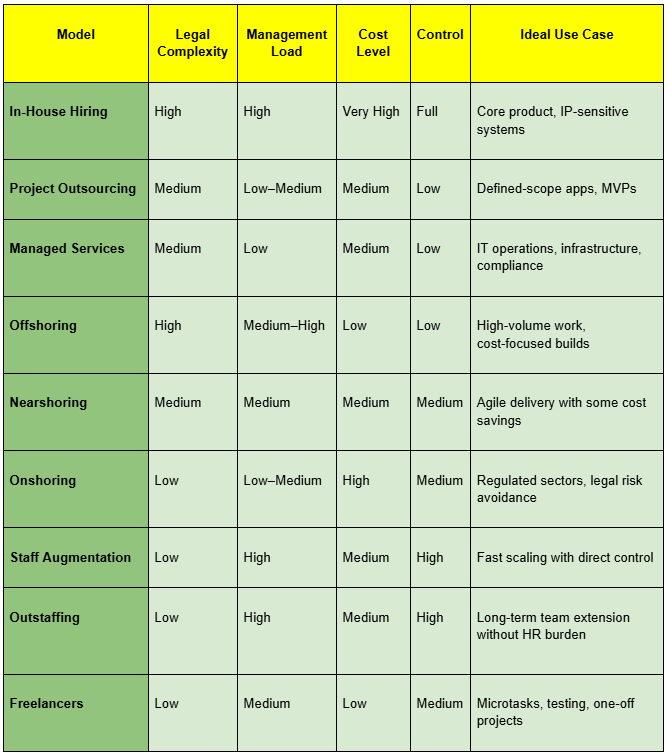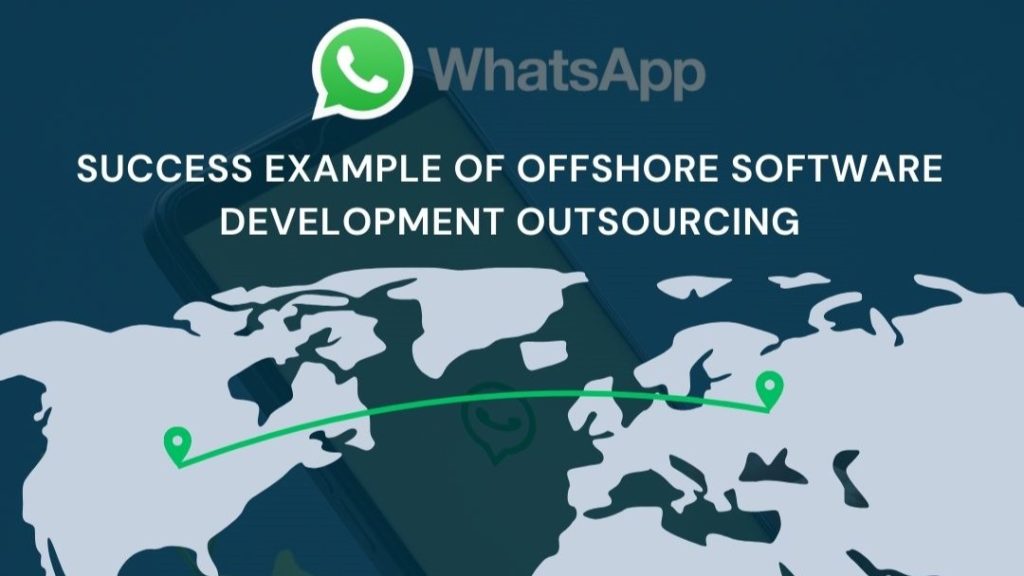
Software development talent sourcing models: Find the right fit.
A comprehensive guide on software development talent sourcing models and strategies, and to finding the right fit for your business.
Companies in the US, Germany, Italy, and worldwide have many software development talent sourcing models available. Expanding software capabilities often means deciding between in-house hiring, various forms of outsourcing (including offshoring, nearshoring, onshoring), and newer models like staff augmentation or outstaffing. Each model differs in how work is delegated, where the team is located, the legal and management effort required, and overall cost. There is no one-size-fits-all solution – a company’s choice depends on its priorities (control vs. cost vs. speed) and context.
This guide dives deep into the leading strategies for sourcing software development talent. Each section unpacks how the model works, when it’s best applied, and what advantages or challenges it brings. We also compare all models across critical decision-making factors such as cost, control, legal exposure, and management overhead. A comparison table and a real-world case study (how WhatsApp leveraged offshoring) are included to illustrate these concepts in practice. For a deep dive into how augmentation works day-to-day, read our ultimate guide to IT staff augmentation.
This article is designed for CTOs, founders, HR leads, and procurement managers looking to make informed, scalable, and sustainable decisions about software development sourcing. Whether you’re managing a fast-growing startup or a mature enterprise, understanding these models will help you design a hybrid approach tailored to your resources and goals.
1. In-House Hiring
Definition: Employing full-time software developers directly under your organization’s payroll, often working from your physical offices or remotely but fully integrated into your teams.
Use Case: Building proprietary systems, developing core platform components, or managing sensitive data where confidentiality and long-term alignment matter.
Advantages:
- Strategic control: Full ownership of decisions, codebase, architecture, and prioritization.
- Team cohesion: Long-term team members absorb company culture, build institutional knowledge, and improve over time.
- Security and compliance: Easier to enforce strict standards around IP, data access, and process governance.
- Cross-functional collaboration: Direct alignment between developers, product managers, design, and leadership improves innovation.
Disadvantages:
- Significant overhead: Recruitment, onboarding, retention, and payroll taxes add to cost.
- Limited scalability: Hiring cycles are often lengthy; talent gaps are hard to fill quickly.
- Geographic limitations: If your local labor market lacks expertise, growth is constrained.
- Talent churn: Developers may leave for higher offers, creating disruption and loss of know-how.
Legal Complexity: High – full compliance with labor laws, benefits, healthcare, and terminations is your responsibility.
Management Load: High – includes people management, career development, performance evaluations, and daily collaboration.
Cost Level: Very High – especially in North America and Western Europe where developer salaries and benefits are among the world’s highest.
Best Fit For:
- Tech-focused companies with stable long-term product roadmaps.
- Companies building core IP or high-security solutions.
- Organizations aiming for strong culture and team retention.
See the full numbers in our in-house hiring vs staff augmentation cost breakdown before you estimate budgets.
2. Project-Based Outsourcing
Definition: Engaging a third-party vendor to deliver a specific project from end to end, typically based on fixed deliverables, timelines, and outcomes.
Use Case: Building a mobile app, developing an MVP, or designing a discrete system module with minimal ongoing iteration.
Advantages:
- Speed to execution: Vendors often have experienced teams that can begin work immediately.
- Lower internal burden: You don’t need to manage the team directly – focus stays on specifications and milestones.
- Budget predictability: Fixed-price contracts allow for upfront cost planning.
- Outcome-focused: You pay for results, not hours worked.
Disadvantages:
- Limited flexibility: Changing scope mid-project can be costly and complex.
- Quality variability: Outcome depends on vendor’s capabilities, processes, and communication.
- Vendor dependency: Once delivered, your team may not understand the codebase or decisions made.
- Integration risks: Project output may not mesh smoothly with your in-house systems.
Legal Complexity: Medium – requires robust contracts, detailed SOWs, IP agreements, and often regional compliance clauses.
Management Load: Low to Medium – client focuses on deliverables, not team oversight.
Cost Level: Medium – often cheaper than building a team, though scope changes can drive up costs.
Best Fit For:
- Short-to-mid-term initiatives where scope is well defined.
- Companies with no internal tech leadership but clear product vision.
3. Managed Services
Definition: A long-term arrangement where a vendor assumes responsibility for delivering continuous IT services or support functions, governed by performance metrics in a service-level agreement (SLA).
Use Case: Hosting infrastructure, cloud administration, system monitoring, DevOps, cybersecurity, or end-user support.
Advantages:
- Reliable uptime and performance: SLAs ensure system availability, backups, updates, and alerts are handled 24/7.
- Reduced internal pressure: Frees up internal teams to focus on product innovation.
- Cost consistency: Monthly or annual pricing helps financial planning.
- Operational expertise: Vendors specialize in maintenance and support, bringing best practices.
Pair managed services with the practices in our guide to managing remote software teams to keep collaboration smooth.
Disadvantages:
- Limited innovation: Managed services focus on stability, not transformation.
- Inflexibility: SLA changes or customizations can be slow and expensive.
- Vendor lock-in: Dependency can develop if knowledge is not transferred.
Legal Complexity: Medium – agreements need to clearly define SLAs, response times, penalties, and data protections.
Management Load: Low – ideal for CIOs or IT heads wanting to reduce routine distractions.
Cost Level: Medium – cost is tied to scope and SLA intensity.
Best Fit For:
- Enterprises with legacy systems.
- Companies requiring consistent infrastructure availability but not looking to innovate.
4. Offshoring
Definition: Partnering with vendors or freelancers located in distant, often lower-cost countries to develop software or provide ongoing technical support.
Use Case: Building a large platform, application, or support operation when cost savings are paramount.
For a quick refresher, our nearshoring vs offshoring overview article explains when distance really matters.
Advantages:
- Significant cost advantage: Talent in markets like India, Ukraine, Vietnam can cost up to 70% less than in the U.S. or Western Europe.
- Global talent pool: Tap into niche skills and volume hiring.
- Scalability: Offshore vendors can rapidly add or remove resources.
- Time zone efficiency: Round-the-clock progress is possible through hand-offs.
Disadvantages:
- Time zone gaps: Communication delays and reduced overlap hours.
- Cultural and language barriers: Misunderstandings are more common.
- Data/IP risk: Ensuring IP protection and legal recourse can be harder.
- Less visibility: Daily management and direct contact may be limited.
Legal Complexity: High – international contracts, export controls, GDPR, and local labor regulations.
Management Load: Medium to High – requires effective tools, routines, and sometimes a local liaison.
Cost Level: Low – especially if teams are well managed and experienced.
Best Fit For:
- High-volume development work.
- Companies looking to extend runway.
5. Nearshoring
Definition: Outsourcing to vendors in nearby countries with closer cultural and time zone alignment.
Use Case: When you need cost savings but value collaboration and speed.
A real-world look at costs and retention appears in our nearshore development in Albania case study.
Advantages:
- Time zone compatibility: Teams can collaborate during overlapping hours.
- Faster communication: Shared working days allow agile, real-time iteration.
- Cultural familiarity: Business ethics, work styles, and holidays are often aligned.
- Geopolitical safety: EU-based or Latin American partners may be preferable to offshore regions.
Disadvantages:
- Smaller price gap: Costs can be 20–40% lower than local, but not drastically cheaper.
- Talent saturation: Some nearshore markets are increasingly competitive.
Legal Complexity: Medium – often simplified by shared trade zones (e.g., EU).
Management Load: Medium – closer proximity improves feedback cycles.
Cost Level: Moderate – better than domestic hiring but not as cheap as Asia or Africa.
Best Fit For:
- Companies in Europe or North America with agile development needs.
- Teams who want face-to-face opportunities without cross-continental travel.
6. Onshoring (Domestic Outsourcing)
Definition: Hiring third-party vendors within your country to deliver software solutions or provide staff.
Use Case: Public sector or highly regulated industries where foreign outsourcing is restricted.
Advantages:
- Legal simplicity: Contracts are governed by national law.
- Easier IP protection and enforcement: Domestic recourse is available.
- No language barriers or major cultural differences
- Easier integration: Onshore vendors can visit on-site.
Disadvantages:
- High cost: Very little labor arbitrage.
- Smaller talent pool: Regional limitations still apply.
Legal Complexity: Low – standard commercial law applies.
Management Load: Low to Medium – depends on engagement model.
Cost Level: High – comparable to in-house hiring.
Best Fit For:
- Projects with high compliance or government involvement.
- Organizations wanting outsourcing benefits without global risk.
7. Staff Augmentation
Definition: Temporarily adding external developers – via agencies or vendors – who work under your management and follow your processes.
Use Case: Expanding a team quickly to meet deadlines, gain expertise, or balance workloads.
Visit our staff augmentation services page for engagement models, onboarding flow, and pricing.
Advantages:
- Immediate scale-up: Adds capacity fast without long recruitment.
- Client control: You manage priorities, code reviews, and workflow.
- Flexibility: Add or remove resources based on current demand.
- No long-term commitments: Engagements can be short-term or renewable.
Disadvantages:
- Management burden: You must integrate and supervise external staff.
- Team cohesion risks: Contractors may feel less engaged.
- Cost inefficiencies if used long-term: Might be more expensive than hiring.
Unsure which is better long-term? Read our outstaffing vs staff augmentation comparison.
Legal Complexity: Low – vendor or agency handles legal employment.
Management Load: High – same as managing internal team members.
Cost Level: Medium – typically includes a markup for vendor margin.
Best Fit For:
- Product companies during rapid scaling phases.
- Teams needing temporary domain experts (e.g., AI, DevOps).
8. Outstaffing
Definition: Building a long-term dedicated remote team that is legally employed by an external provider but works full-time under your direction.
Use Case: Building a distributed engineering team without opening a foreign office or handling HR abroad.
Advantages:
- Dedicated resources: Outstaffed developers work solely on your projects.
- HR burden offloaded: The vendor handles compliance, benefits, and payroll.
- Scalable: Easily grow or reduce the team as needed.
- Continuity: More stable than freelancers or short-term staff aug.
Disadvantages:
- Vendor dependency: You rely on the partner to retain talent.
- Team integration effort: Remote employees need intentional culture-building.
Legal Complexity: Low – vendor assumes employment risk.
Management Load: High – you’re still managing performance and collaboration.
Cost Level: Medium – generally lower than local employees.
Best Fit For:
- Companies seeking full-time team expansion.
- Startups building offshore teams without legal presence abroad.
9. Freelancers (Gig Model)
Definition: Independently contracted developers engaged for specific short-term tasks, usually through platforms or direct outreach.
Use Case: One-off projects, MVP features, quick bug fixes, design iterations.
Advantages:
- Extreme flexibility: Hire by the hour or task.
- Wide availability: Global platforms like Upwork or Toptal offer many choices.
- Low cost for micro-projects: Pay only for what’s needed.
Solo developers increasingly lean on automation: see our AI-powered coding tools trend report for what’s next.
Disadvantages:
- Quality variance: Requires vetting and references.
- Lack of loyalty or continuity: May switch clients frequently.
- Management overhead: Especially when hiring multiple freelancers.
Legal Complexity: Low – use simple contracts or platform T&Cs.
Management Load: Medium – clear briefs and oversight are key.
Cost Level: Low to Medium – competitive but can scale up with top-tier talent.
Best Fit For:
- MVPs and design sprints.
- Startups and SMEs needing quick iterations.
Comparative Summary Table

Real-World Example: WhatsApp’s Offshore Model

In its early stages, WhatsApp famously offshored most of its engineering work to Eastern Europe. The company operated with a lean U.S.-based leadership team while relying on highly skilled offshore developers for backend infrastructure. This strategy allowed them to scale with minimal costs and fewer hiring bottlenecks.
By the time of its $19B acquisition by Facebook in 2014, WhatsApp had only 55 employees. Its success illustrates how smart offshoring – combined with in-house vision – can lead to massive scalability without massive payrolls.
Final Thoughts
The decision to build, outsource, augment, or offshore software development is no longer binary. Smart organizations layer these models strategically:
- Use in-house teams for leadership, core systems, and innovation.
- Outsource complete builds when internal teams are maxed out.
- Engage freelancers for time-sensitive gaps.
- Build long-term offshore teams via outstaffing to expand reach.
Whatever your goals – cost optimization, time-to-market, innovation – there is a sourcing model that fits. But success isn’t just about choosing a model. It’s about execution: defining roles, aligning expectations, managing deliverables, and fostering trust across distance and time zones.
With hybrid work becoming the default, mastering these models is essential not just for growth – but survival. The organizations that succeed in the next decade will be those that treat talent sourcing not as a transaction, but as a core part of their strategy. When internal capacity is stretched, our complete staff-augmentation guide shows how to scale responsibly.